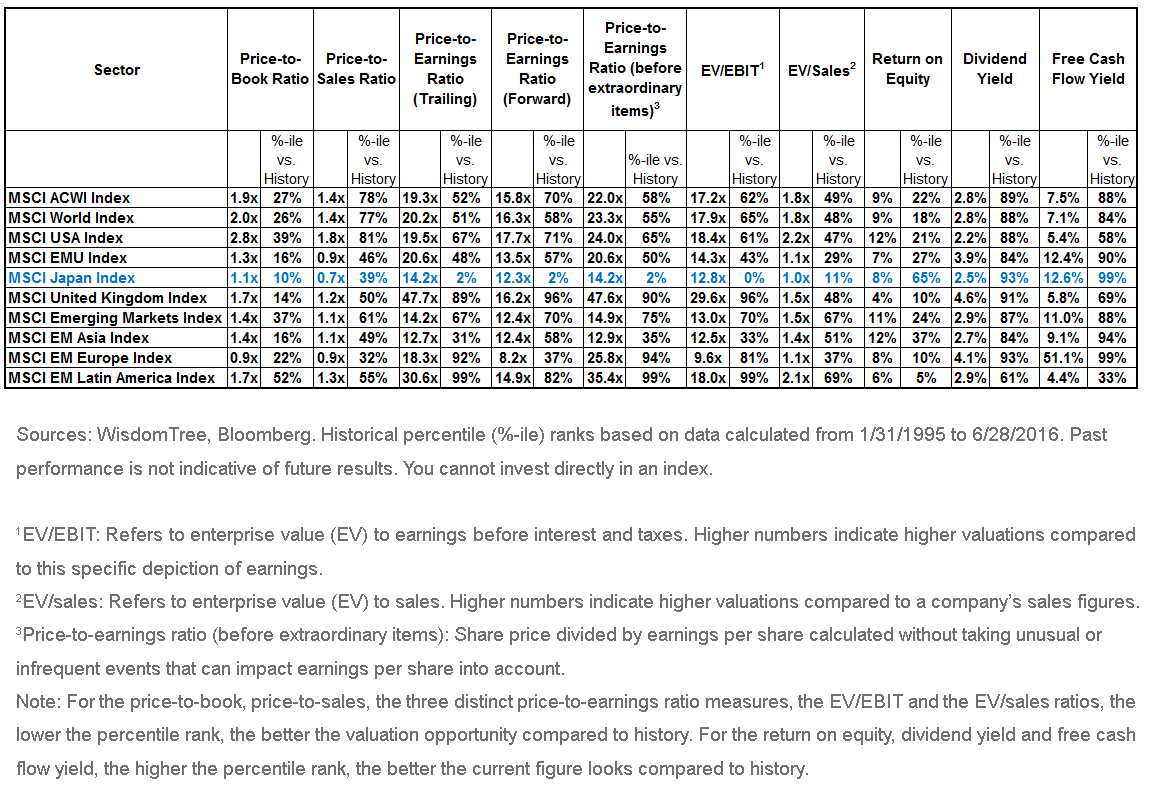Japan Is Inexpensive—Where to Look for Performance


 …But Is Japan a “Value Trap”?
While valuations are very attractive, performance ratios appear less so: Japan’s return on equity (ROE) stands at 8%, which is not just below the 9% of the MSCI World but also at the 68% percentile mark—high by historical standards measured against its own history. Ditto for the dividend yield, 2.5% currency, which is in the 93rd percentile compared to its history. This is where our key pillar of the Japan bull thesis comes in: Corporate governance has fundamentally changed, and capital stewardship is now a principal focus for corporate managers. Equity returns and dividends are on a structural up-trend, in our view. The economic dynamic here is Japan’s declining savings rate, forcing higher rates of return, with the newly introduced Stewardship Code2 and Governance Code3 helping to engender management behavior. The fact that Japan boasts a 12.6% free cash flow yield—MSCI World is 7.1%—suggests there is ample room for a structural rise in shareholder returns.
Trigger One: “Show Me the Money” at Upcoming Earnings Season
Here, the upcoming earnings results season should prove key to convincing investors that capital stewardship is really changing for the better: The April–June period is expected to be a second consecutive quarter of earnings declines. We will want to see confirmation that dividends will be maintained or even increased and share buybacks continue. The upcoming results season will be all about “show me the money” (from a shareholder perspective). If, as we suspect, dividend growth and share buyback momentum can be maintained, this should be the first concrete trigger to help overcome Japanese value trap fears (the April–June earnings results season will peak in early August).
Trigger Two: Coordinated Monetary & Fiscal Stimulus
A second positive performance trigger is poised to come from, yes, “Abenomics.” Specifically, a pro-growth boost to aggregate demand is on its way, likely to be delivered by end-August/early September, in our view. Prime Minister Shinzo Abe has already instructed technocrats to prepare a supplementary fiscal boost. Here, an added ¥4 trillion to ¥5 trillion of public infrastructure investment for the reconstruction of the Kumamoto earthquake devastation is bound to be the mainstay. Added elements are expected to bring fiscal support for regional enterprises as well as a new round of cash transfers to the working poor. How exactly helicopter money will be administered is heavily debated, but the helicopter money question appears to have moved from “should” to “how?” In our view, a one-off gift from the treasury to the working poor has become likely.
Most importantly, Team Abe is very focused on coordinating added fiscal spending with the Bank of Japan. Specifically, there is great awareness of the diminishing returns from monetary policy. The focus is on linking the central bank balance sheet more directly to aggregate demand. In practical terms, this means that the financing of the coming fiscal boost is poised to come from the BOJ. In our view, the BOJ will increase its quantitative easing by basically the same amount that the MoF will need to fund the extra budget. We expect a deficit-bond-funded extra budget of ¥8 trillion to ¥10 trillion and a boost in the BOJ’s balance sheet growth target from the current ¥80 trillion to between ¥88 trillion and ¥90 trillion.
For Japanese large-cap equities, we are approaching a positive turning point, in our view. Valuations are now very attractive, and concrete performance triggers are likely from both micro and macro dynamics unfolding. The time has come to re-engage in Japanese large caps, in our view.
1Source: Bloomberg, with data measured from 8/10/15 to 6/28/16.
2Stewardship Code: “Principles for Responsible Institutional Investors, Japan’s Stewardship Code: To Promote Sustainable Growth of Companies through Investment and Dialogue,” Financial Services Agency, 2/26/14.
3Governance Code: “Japan’s Corporate Governance Code: Seeking Sustainable Corporate Growth and Increased Corporate Value over the Mid- to Long-Term,” JPX: Tokyo Stock Exchange, 6/1/15.
…But Is Japan a “Value Trap”?
While valuations are very attractive, performance ratios appear less so: Japan’s return on equity (ROE) stands at 8%, which is not just below the 9% of the MSCI World but also at the 68% percentile mark—high by historical standards measured against its own history. Ditto for the dividend yield, 2.5% currency, which is in the 93rd percentile compared to its history. This is where our key pillar of the Japan bull thesis comes in: Corporate governance has fundamentally changed, and capital stewardship is now a principal focus for corporate managers. Equity returns and dividends are on a structural up-trend, in our view. The economic dynamic here is Japan’s declining savings rate, forcing higher rates of return, with the newly introduced Stewardship Code2 and Governance Code3 helping to engender management behavior. The fact that Japan boasts a 12.6% free cash flow yield—MSCI World is 7.1%—suggests there is ample room for a structural rise in shareholder returns.
Trigger One: “Show Me the Money” at Upcoming Earnings Season
Here, the upcoming earnings results season should prove key to convincing investors that capital stewardship is really changing for the better: The April–June period is expected to be a second consecutive quarter of earnings declines. We will want to see confirmation that dividends will be maintained or even increased and share buybacks continue. The upcoming results season will be all about “show me the money” (from a shareholder perspective). If, as we suspect, dividend growth and share buyback momentum can be maintained, this should be the first concrete trigger to help overcome Japanese value trap fears (the April–June earnings results season will peak in early August).
Trigger Two: Coordinated Monetary & Fiscal Stimulus
A second positive performance trigger is poised to come from, yes, “Abenomics.” Specifically, a pro-growth boost to aggregate demand is on its way, likely to be delivered by end-August/early September, in our view. Prime Minister Shinzo Abe has already instructed technocrats to prepare a supplementary fiscal boost. Here, an added ¥4 trillion to ¥5 trillion of public infrastructure investment for the reconstruction of the Kumamoto earthquake devastation is bound to be the mainstay. Added elements are expected to bring fiscal support for regional enterprises as well as a new round of cash transfers to the working poor. How exactly helicopter money will be administered is heavily debated, but the helicopter money question appears to have moved from “should” to “how?” In our view, a one-off gift from the treasury to the working poor has become likely.
Most importantly, Team Abe is very focused on coordinating added fiscal spending with the Bank of Japan. Specifically, there is great awareness of the diminishing returns from monetary policy. The focus is on linking the central bank balance sheet more directly to aggregate demand. In practical terms, this means that the financing of the coming fiscal boost is poised to come from the BOJ. In our view, the BOJ will increase its quantitative easing by basically the same amount that the MoF will need to fund the extra budget. We expect a deficit-bond-funded extra budget of ¥8 trillion to ¥10 trillion and a boost in the BOJ’s balance sheet growth target from the current ¥80 trillion to between ¥88 trillion and ¥90 trillion.
For Japanese large-cap equities, we are approaching a positive turning point, in our view. Valuations are now very attractive, and concrete performance triggers are likely from both micro and macro dynamics unfolding. The time has come to re-engage in Japanese large caps, in our view.
1Source: Bloomberg, with data measured from 8/10/15 to 6/28/16.
2Stewardship Code: “Principles for Responsible Institutional Investors, Japan’s Stewardship Code: To Promote Sustainable Growth of Companies through Investment and Dialogue,” Financial Services Agency, 2/26/14.
3Governance Code: “Japan’s Corporate Governance Code: Seeking Sustainable Corporate Growth and Increased Corporate Value over the Mid- to Long-Term,” JPX: Tokyo Stock Exchange, 6/1/15.
Important Risks Related to this Article
Investments focused in Japan increase the impact of events and developments associated with the region, which can adversely affect performance.


